This cache was created by an

To log this cache, you will NOT be looking for a typical geocache container (in fact, there IS no container to find). Rather, to prove you were here and learned something you'll need to find the answers to the given questions (found at the end of this description), which you will then email me, the owner (this is the same process for ALL Earthcaches).
So go ahead and log your experience while here, submit photos, etc., but email your answers to me (not in your visit log) to get credit for "finding" this cache. If it seems too complicated, don't sweat it too much (as long as I can see that you made an honest effort to answer all of the questions, that is fine). Remember that the purpose of this is to learn something, and most importantly, to have fun! Also, feel free to email me with any questions you may have, I'd be happy to help. 
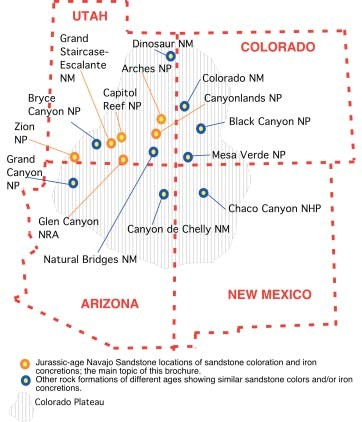
Red Rock Country
Sandstone can exhibit many colors, but landscapes of the American Southwest (as shown here by the Vermilion Cliffs National Monument Area) that exhibit such striking shades of red have been informally called "red rock country" (portions of which are also called "canyon country" where deeply incised canyons exist, also nearby in the Grand Canyon Area). The rock unit called the Navajo Sandstone features prominently in much of this landscape, and contains some of the largest and most abundant iron concretions found anywhere in the world. The Navajo Sandstone was named for the “Navajo country” of Arizona, Utah, and New Mexico. The red rock country on the Colorado Plateau where the Navajo Sandstone and other related rock formations are prominently exposed is centered around the Four Corners region where the states of Utah, New Mexico, Colorado, and Arizona meet. This story of the red rocks started millions of years ago.
Long Ago and Far Away
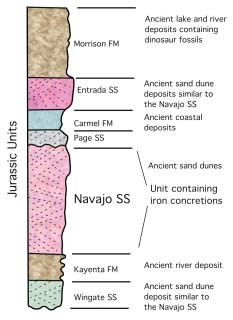
This story begins millions of years ago in a world and landscape very different from today: during the Jurassic Period (144-206 million years ago) when the North American continent was at a different latitude, and this area was close to the equator in a belt of strong trade winds. These winds moved quartz sand to build dunes that covered an area bigger than the Sahara Desert. An accumulation of desert sand dunes is called an "erg" or "sand sea." The largest erg to ever exist in North America is preserved in the Jurassic-age Navajo Sandstone (approximately 180-190 million years old) that is up to 2,500 feet (750+ m) thick. The Navajo Sandstone was deposited over a broad area of the Colorado Plateau and is now well exposed in national parks and monuments such as Zion, Capitol Reef, Arches, Canyonlands, Grand Staircase-Escalante, and a number of surrounding areas, including near here. Other rock formations such as the Wingate Sandstone and Entrada Sandstone (see figure of Jurassic units) are also ancient sand dune deposits that show similar coloration and iron concretions. However, the Navajo Sandstone is especially unique because it displays such a wide range of color (from white to many shades of red) and contains some of the greatest variety of iron concretions found anywhere in the world.
Blood of the Living Rocks
What colors the sandstone red? The red color is caused by a union of iron and oxygen (an iron oxide) known as hematite (Fe2O3), a mineral named from the Greek word for blood. Iron is a powerful pigment present in many sediments and rocks, thus it commonly imparts color to the rocks. Although red is the common pigment color, not all iron oxides are red; some are brown or yellow (minerals - limonite or goethite), and some are black (mineral - magnetite). Some iron minerals are metallic yellow (mineral - pyrite consisting of iron sulfide) or green (minerals - chlorite or clay consisting of iron silicate). Although geologists have long understood that sandstone coloration is a function of varying amounts of iron, it is only recently that scientific studies detail how this happens.
The Crimson Source
What is the origin of the red pigment in sandstone? The origin of the color is due to a chemical reaction similar to rusting of a nail. An iron nail appears silver in color and metallic. When a nail rusts due to the addition of water molecules and oxygen, two or three iron electrons are lost to oxygen (the iron is oxidized). The remaining electrons, together with the oxygen, absorb all of light’s colors except red and brown. But iron nails don't color sandstones red.
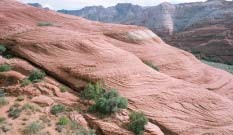
Sandstone originates from the breakdown of older rocks, a process called weathering. Granite, for example, is a type of igneous rock that commonly breaks down in weathering to produce sand grains that later make up sandstone. The older “parent” rocks often have minerals that contain some iron, but these minerals are green or dark brown. Water in contact with the atmosphere absorbs oxygen. Dissolved oxygen in water is very aggressive in removing electrons from iron to produce rust (oxidized iron). As the iron-bearing minerals weather and react with oxygen and water from the atmosphere, the iron is released and forms very thin, paint-like coatings of hematite on the quartz sand grains. Iron in hematite that has lost three electrons absorbs most of the visible colors of light and only red is transmitted to produce the mineral’s red coloration. Sands deposited in deserts gradually redden as iron minerals break down and lend their red coloration to the sand. The reddening continues after burial as more overlying sedimentary units are added. Over millions of years, these loose sand grains are compressed and cemented into the rock called sandstone (as you can see here). In these red sandstones, microscopic, oxidized iron films of the mineral hematite spread and coat the quartz grains. The amount of hematite is very small, but since iron is a powerful pigment a little red goes a long way!
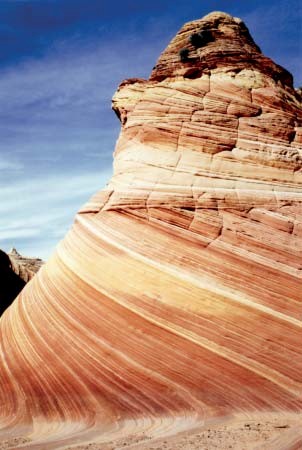
Big-Time Bleaching
What happened to make normally red sandstone white? Sandstone is porous and per- meable because there are holes or spaces between sand grains. Sand dunes make particularly permeable sandstone because wind effectively sorts the grains to create a homogeneous deposit with uniform grain size and not much fine-grained pore fillings. Given enough pressure and force, water moves relatively easily through porous sandstone almost like water through a sponge. Even during heavy rains with much surface runoff, some water infiltrates the sandstone. Under certain conditions, iron pigment will dissolve in water and be removed, or be rendered colorless by chemical reactions with the water. This is much like a bleaching detergent permeating a red cloth, removing color as it spreads. (However, household chlorine bleach won’t take out iron rust stains because chlorine is not chemically able to move iron).
So how does bleaching happen chemically? Some waters contain reducing agents (electrons are added to the iron atom and oxygen is removed) that make the iron soluble (dissolvable) in water. To make iron soluble, the water can restore one of the electrons that was lost by iron during early weathering and oxidation. Fluids such as hydrocarbons (petroleum), weak acids (vinegar-like), or those with hydrogen sulfide (gas that smells like rotten eggs) can also restore an electron to iron, thus these are called "reducing waters." This water can dissolve and remove nearly all of the hematite and bleach red sandstone to white. Some layers of sandstone will be more porous than others however, and so sometimes you can end up with layers or bands of varying colors of sandstone. Also, the comparatively soft nature of sandstone (versus other rocks) often leads to unique weathering formations, such as the nearby hoodoos (precariously perched boulders upon a narrow balancing point; see picture below) you ought to check out.
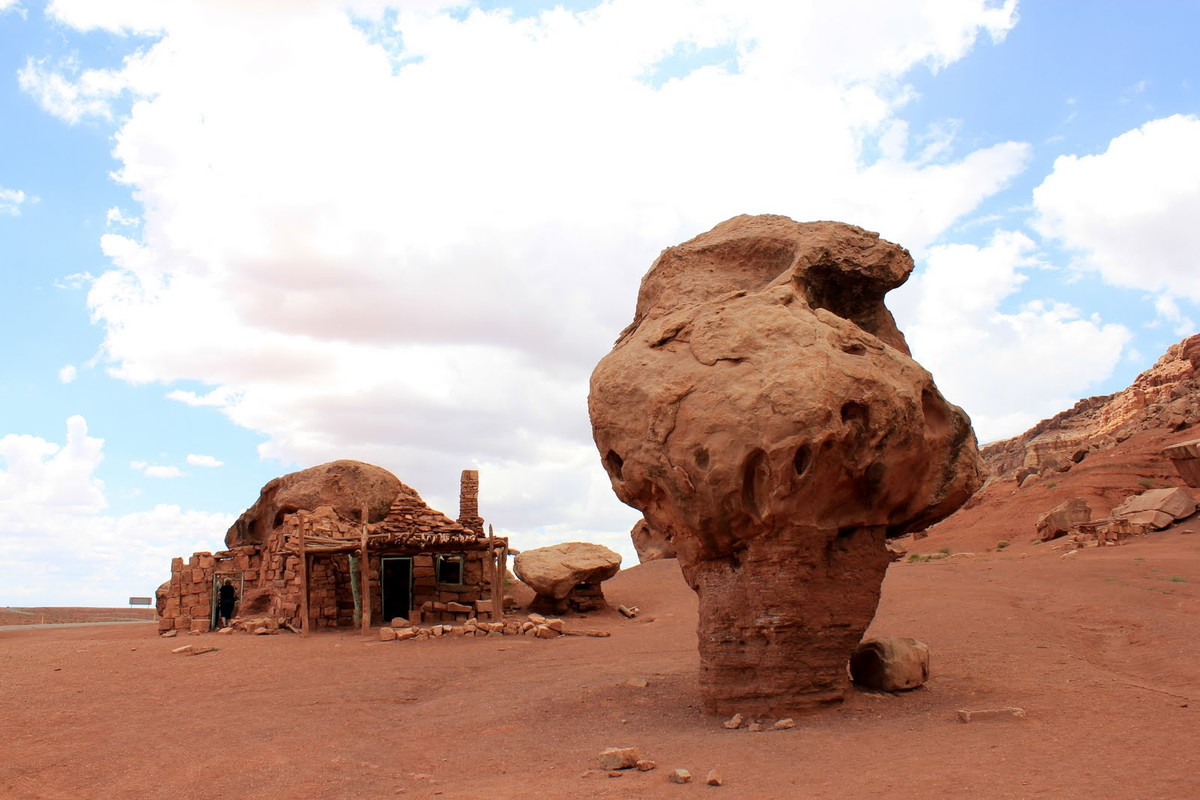
The above information (including most pictures) is sourced (with several minor adaptations) from:
"Rainbow of Rocks: Mysteries of Sandstone Colors and Concretions in Colorado Plateau Canyon Country"
By Marjorie A. Chan and William T. Parry
found originally at: http://geology.utah.gov/online/pdf/pi-77.pdf
Again, remember: to log this cache, use the following info, your surroundings and head to answer the following questions (you only need to answer either question 1a or 1b, and then either 2a or 2b for a total of 2 questions):
1a: Long Ago and Far Away: What is an erg? How are ergs related to the creation of the nearby sandstone? Explain.
OR 1b: Blood of the Living Rocks: Describe a nearby example of red sandstone. What created this red color?
2a: Big-Time Bleaching, A: Find an example of white sandstone nearby, and briefly describe it. What likely happened to make this sandstone turn white?
OR 2b: Big-Time Bleaching, B: Describe the nearby hoodoos (composition, size, color, texture, etc.). How do you suppose they were created? Think about the qualities of sandstone, as well as your surroundings and make an educated guess.
Don't forget to email your answers to me, not in your visit log, to get credit for "finding" this cache.